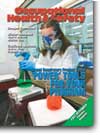
November 2004
Cover Story
By John L. Hierbaum
DOUBTLESSLY, you have heard that "You must use the proper tools to make the job easier and to end up with the desired result!" Well, this statement applies not only to the traditional hand and power tools you use for home projects and specialized tools you use on the job, but also to the sound respiratory protection program that should be followed in the workplace.
Features
By Jerry Laws
PUBLISHED in August 2003, ANSI Z87.1-2003, the revised American National Standard for Occupational and Educational Eye and Face Protection Devices, brought end users, eye care practitioners, and PPE suppliers a new classification system--"Basic Impact" and "High Impact" protectors--with testing requirements and performance criteria to support it. Z87.1
By Fred Drennan
ON June 20, 2002, President George W. Bush signed an Executive Order to promote personal fitness in the general public.
By Fred Elliott
OLD Man Winter brings to mind two safety concerns in particular: hypothermia and slip-and-fall injuries.
By Robert Brown
I started (and continue) my professional career, for better or worse, in the Golden State of California. As a result, much of my early understanding of health and safety management practices was framed around the early requirements of California's Occupational Safety and Health Division (Cal/OSHA).
By Andy Coats
WHEN performing a quantitative respirator fit test (QNFT), the "way it's always been done" has been to perform several exercises as stated in the accepted protocols listed in the respiratory protection standards of the Federal Register (29 CFR 1910.134).
By Jim Smith
DESPITE billions of dollars spent on vehicle safety improvements, highway fatalities in 2003 reached their highest level since 1990. Traffic accidents remain the number one cause of on-the-job deaths.
By Stan Kummer
IN the workplace, excessive amounts of heat emitted by machinery or escaping from containers can be a sign of something more serious.
By Jerry Laws
THE biggest electrical threat to workers is no secret: Power lines, especially overhead power lines, are Public Enemy Number One. Contact with power lines is killing about 133 American workers each year--mostly but not entirely in the construction industry, with victims working mostly but not entirely for small businesses, said Michael G. Clendenin, executive director of the Electrical Safety Foundation International in Rosslyn, Va.
By Erik Johnson
OSHA regulations for the use of chemical cartridges require the establishment of change schedules based on objective information. One of the most commonly used mathematical models for estimating the service life of organic vapor (OV) cartridges was developed by Wood.
By Nancy Westcott
AS the realities of resource depletion and global environmental degradation become more evident, we can see a maturing and strengthening of the public's concern for and knowledge of the broad goals of environmental issues.
Departments
By Ronnie Rittenberry
BAD traffic accidents usually bring them out. Drive-by shootings, rapes, homicides, and other crimes can summon them, as can natural disasters.
By Jerry Laws
OUR company recently instituted drug tests for prospective employees. We could be doing much more: I believe our policy should include reasonable cause, post-accident, and possibly random testing of every employee. Shouldn't workplace drug testing be almost universal by now?
By Andrew N. Reyburn
ALTHOUGH compliance is important, it is no longer the driving force in modern safety management. What is? Reducing costs, specifically reducing insurance premiums, is the primary driver.